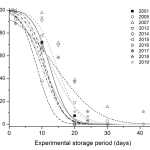Plant Science Research Weekly: November 4, 2022
Update: Plant energy expenses: How to stretch the C budget
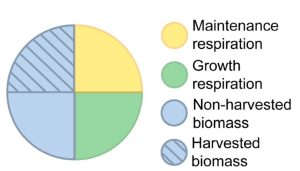 Balancing the books means making sure that expenses don’t exceed income. In terms of a plant’s energy budget, most of the input comes from carbon fixed during photosynthesis. The output is much more diverse. Some fixed carbon is used for growth and stored in seeds, and some is respired to release ATP and reducing power to drive other reactions. Bathe et al. carried out an energy audit to identify the feasibility of stretching the plant carbon budget to address environmental concerns. They focused on three models: storing stable carbon below ground, enhancing biological nitrogen fixation, and decreasing the turnover of short-lived enzymes. It’s an interesting an accessible paper that is worth a read, but their take-home message is that below-ground C sequestration and biological N fixation efforts will have little impact without simultaneously trimming the energy waste that accompanies high rates of protein turnover. In other words, pay off your high-interest credit card balance before your next buying binge! (Summary by Mary Williams @PlantTeaching) Plant Physiol. 10.1093/plphys/kiac493
Balancing the books means making sure that expenses don’t exceed income. In terms of a plant’s energy budget, most of the input comes from carbon fixed during photosynthesis. The output is much more diverse. Some fixed carbon is used for growth and stored in seeds, and some is respired to release ATP and reducing power to drive other reactions. Bathe et al. carried out an energy audit to identify the feasibility of stretching the plant carbon budget to address environmental concerns. They focused on three models: storing stable carbon below ground, enhancing biological nitrogen fixation, and decreasing the turnover of short-lived enzymes. It’s an interesting an accessible paper that is worth a read, but their take-home message is that below-ground C sequestration and biological N fixation efforts will have little impact without simultaneously trimming the energy waste that accompanies high rates of protein turnover. In other words, pay off your high-interest credit card balance before your next buying binge! (Summary by Mary Williams @PlantTeaching) Plant Physiol. 10.1093/plphys/kiac493
Review: The cell biology of primary cell walls during salt stress
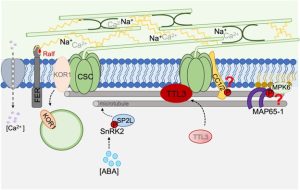 Salt is a massive problem for most land plants. At the macroscopic level, excess soil salinity can cause stunting or death. At the molecular / cellular level, salinity causes both osmotic and ionic challenges that affect membrane homeostasis, molecular interactions, and protein stability. A new review by Colin et al. focuses on the effects of salt stress on primary cell walls, where salinity is first experienced. Cell walls, even primary cell walls, are extremely complex, heterogenous composite structures held together by covalent and ionic bonds, and communicate directly with the underlying plasma membrane and cytoskeleton. Although we have some insights into where and how salinity is sensed at the membrane and within the cytosol, less is known about salt-sensing in the apoplast, making this a particularly interesting read. As the authors describe, Na+ can interfere with the interactions between Ca2+ and pectins, leading to cell wall instability (CWI) and the CWI-response, which involves the protein kinase FERONIA (FER). Salt also directly and indirectly (through effects on the cytoskeleton) affects cellulose synthase complexes, as reviewed here. Given that salt is one of the major environmental stresses affecting plants, and there have been several new insights into how salinity affects cell walls, this is an important and timely review. (Summary by Mary Williams @PlantTeaching) Plant Cell 10.1093/plcell/koac292
Salt is a massive problem for most land plants. At the macroscopic level, excess soil salinity can cause stunting or death. At the molecular / cellular level, salinity causes both osmotic and ionic challenges that affect membrane homeostasis, molecular interactions, and protein stability. A new review by Colin et al. focuses on the effects of salt stress on primary cell walls, where salinity is first experienced. Cell walls, even primary cell walls, are extremely complex, heterogenous composite structures held together by covalent and ionic bonds, and communicate directly with the underlying plasma membrane and cytoskeleton. Although we have some insights into where and how salinity is sensed at the membrane and within the cytosol, less is known about salt-sensing in the apoplast, making this a particularly interesting read. As the authors describe, Na+ can interfere with the interactions between Ca2+ and pectins, leading to cell wall instability (CWI) and the CWI-response, which involves the protein kinase FERONIA (FER). Salt also directly and indirectly (through effects on the cytoskeleton) affects cellulose synthase complexes, as reviewed here. Given that salt is one of the major environmental stresses affecting plants, and there have been several new insights into how salinity affects cell walls, this is an important and timely review. (Summary by Mary Williams @PlantTeaching) Plant Cell 10.1093/plcell/koac292
Nitrogen-dependent binding of the transcription factor PBF1 contributes to the balance of protein and carbohydrate storage in maize endosperm
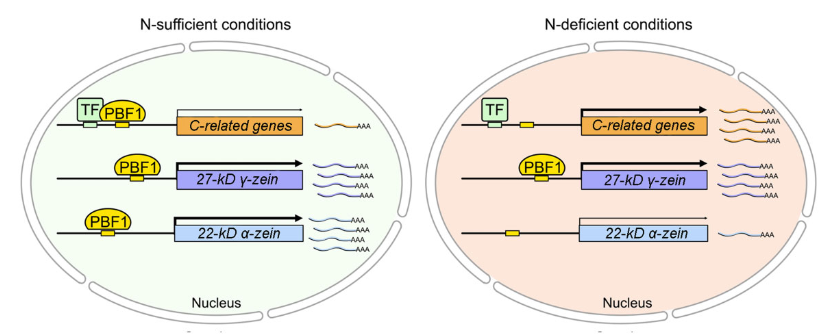 The majority of maize endosperm is made of starch (70%) and proteins (10%) and their biosynthesis is a complex process which involves many enzymes. N-containing compounds, such as enzymes, amino acids, and nucleotides are crucial for C metabolism. Thus, when N levels are altered, the storage of proteins and starch in maize is notably affected. Several transcription factors (TFs) are involved in starch and protein metabolism in maize endosperm. Prolamin-box binding factor 1 (PBF1) it is known to be involved in the regulation of both C and N metabolism due to the presence of a conserved sequence named P-box. Variation in N supply will consequently affect the composition of starch and protein in the endosperm. Ning et al. performed an RNA-Seq to identify how the N levels affect the accumulation of starch and proteins in the endosperm. The authors observed an enrichment of the P-box sequence in the promoters of the Differentially Expressed Genes (DEGs) suggesting a possible role of PBF1. With the results of a chromatin immunoprecipitation followed by sequencing (ChIP-Seq) it was demonstrated that it is the binding pattern of PBF1 (rather than its abundance) that was altered based on N availability. These results shed light to into the development of maize varieties with improved nutritional value and stable yield. (Summary by Eva Maria Gomez Alvarez, @eva_ga96). The Plant Cell. 10.1093/plcell/koac302
The majority of maize endosperm is made of starch (70%) and proteins (10%) and their biosynthesis is a complex process which involves many enzymes. N-containing compounds, such as enzymes, amino acids, and nucleotides are crucial for C metabolism. Thus, when N levels are altered, the storage of proteins and starch in maize is notably affected. Several transcription factors (TFs) are involved in starch and protein metabolism in maize endosperm. Prolamin-box binding factor 1 (PBF1) it is known to be involved in the regulation of both C and N metabolism due to the presence of a conserved sequence named P-box. Variation in N supply will consequently affect the composition of starch and protein in the endosperm. Ning et al. performed an RNA-Seq to identify how the N levels affect the accumulation of starch and proteins in the endosperm. The authors observed an enrichment of the P-box sequence in the promoters of the Differentially Expressed Genes (DEGs) suggesting a possible role of PBF1. With the results of a chromatin immunoprecipitation followed by sequencing (ChIP-Seq) it was demonstrated that it is the binding pattern of PBF1 (rather than its abundance) that was altered based on N availability. These results shed light to into the development of maize varieties with improved nutritional value and stable yield. (Summary by Eva Maria Gomez Alvarez, @eva_ga96). The Plant Cell. 10.1093/plcell/koac302
New insights into how plant cells traffic proteins into the vacuole: Role of the amphisome
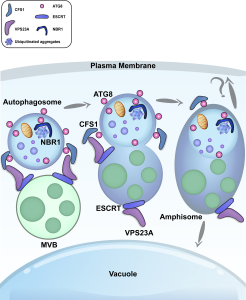 Some of the most fascinating questions in biology, subject to numerous Nobel Prizes, center on how all the parts of a eukaryotic cell are spatially and temporally coordinated, to allow the plethora of often incompatible functions to occur in harmony. Studies in three major systems, yeast, metazoans, and plants, reveal many commonalities arising from their long-gone common ancestor, but also divergences. Protein and organelle turnover or recycling is just as important as synthesis for proper cell function. Here, Zhao et al. identify a key facet of this process in plants, the delivery of material from the autophagosomes to the central vacuole. Autophagosomes (“self-eaters”) are conserved, double-membrane bound structures that participate in nutrient homeostasis, defense, and differentiation. Previous studies identified ATG8 as a conserved membrane-bound protein specifically found on autophagosomes. Using ATG8 as bait, the authors identified CFS1 (cell death related endosomal FYVE/SYLF protein 1) as a key protein that binds to both the autophagosome and multivesicular bodies, bringing them together into a compartment called an amphisome. The authors propose that vacuolar trafficking is organized as a “hub and spoke” type distribution system, where amphisomes serve as sorting hubs for multivesicular bodies and autophagosomes. (Summary by Mary Williams @PlantTeaching) J. Cell Biol. 10.1083/jcb.202203139
Some of the most fascinating questions in biology, subject to numerous Nobel Prizes, center on how all the parts of a eukaryotic cell are spatially and temporally coordinated, to allow the plethora of often incompatible functions to occur in harmony. Studies in three major systems, yeast, metazoans, and plants, reveal many commonalities arising from their long-gone common ancestor, but also divergences. Protein and organelle turnover or recycling is just as important as synthesis for proper cell function. Here, Zhao et al. identify a key facet of this process in plants, the delivery of material from the autophagosomes to the central vacuole. Autophagosomes (“self-eaters”) are conserved, double-membrane bound structures that participate in nutrient homeostasis, defense, and differentiation. Previous studies identified ATG8 as a conserved membrane-bound protein specifically found on autophagosomes. Using ATG8 as bait, the authors identified CFS1 (cell death related endosomal FYVE/SYLF protein 1) as a key protein that binds to both the autophagosome and multivesicular bodies, bringing them together into a compartment called an amphisome. The authors propose that vacuolar trafficking is organized as a “hub and spoke” type distribution system, where amphisomes serve as sorting hubs for multivesicular bodies and autophagosomes. (Summary by Mary Williams @PlantTeaching) J. Cell Biol. 10.1083/jcb.202203139
Concentration-dependent transcriptional switching through a collective action of cis-elements
 One of the well-known molecular pathways that regulate plant development is the one formed by the homeobox transcription factor WUSCHEL (WUS) and the secreted peptide CLAVATA 3 (CLV3). In the shoot apical meristem (SAM), WUS expression is constrained to the organizing center where it maintains the stem cell population. WUS protein migrates to adjacent cells creating a concentration gradient that activates CLV3, its own negative regulator. But, at the same time, high WUS concentration leads to protein dimerization and CLV3 repression. Here, Rodriguez et al. combine biochemical analyses together with exhaustive computational modeling to answer the question of how WUS levels guide this balance between CLV3 transcriptional activation and repression. WUS binds to a module of five cis-elements in the CLV3 promoter. The authors demonstrate that the individual affinity of each site as well as the number of elements define CLV3 expression. Furthermore, the spacing between these cis-elements is also critical since it determines the cooperativity of WUS binding. Higher distance increases the affinity for WUS monomers, which promotes CLV3 activation, thus revealing a new cofactor-independent mechanism of regulation of transcription factor binding. Overall, their models reveal the particular conditions required to recreate CLV3 spatial expression specificity. This knowledge can be used in the future to precisely engineer the stem cell dynamics in the SAM, thereby modulating plant growth. (Summary by Daniel Alique, @daniel_alique) Science Advances 10.1126/sciadv.abo6157.
One of the well-known molecular pathways that regulate plant development is the one formed by the homeobox transcription factor WUSCHEL (WUS) and the secreted peptide CLAVATA 3 (CLV3). In the shoot apical meristem (SAM), WUS expression is constrained to the organizing center where it maintains the stem cell population. WUS protein migrates to adjacent cells creating a concentration gradient that activates CLV3, its own negative regulator. But, at the same time, high WUS concentration leads to protein dimerization and CLV3 repression. Here, Rodriguez et al. combine biochemical analyses together with exhaustive computational modeling to answer the question of how WUS levels guide this balance between CLV3 transcriptional activation and repression. WUS binds to a module of five cis-elements in the CLV3 promoter. The authors demonstrate that the individual affinity of each site as well as the number of elements define CLV3 expression. Furthermore, the spacing between these cis-elements is also critical since it determines the cooperativity of WUS binding. Higher distance increases the affinity for WUS monomers, which promotes CLV3 activation, thus revealing a new cofactor-independent mechanism of regulation of transcription factor binding. Overall, their models reveal the particular conditions required to recreate CLV3 spatial expression specificity. This knowledge can be used in the future to precisely engineer the stem cell dynamics in the SAM, thereby modulating plant growth. (Summary by Daniel Alique, @daniel_alique) Science Advances 10.1126/sciadv.abo6157.
Drought resistance or yield? In search of gold, we lost the diamond
 Artificial selection has significantly increased crop yield. However, this has come at the cost of compromising abiotic stress tolerance. Stomatal aperture has an important role in abiotic stress tolerance. Abiotic stress induces stomatal closure and involves the intracellular production of reactive oxygen species (ROS) in guard cells. To unravel the underlying molecular modulators contributing to this tradeoff, a genome-wide association study was conducted recently by Gao et al. They reported that drought tolerance is conferred by a natural variant of ZmSRO1d, which encodes a mono-ADP-ribosyltransferase (SRO: SIMILAR TO RCD-ONE; rcd1 mutants are hypersensitive to ROS). The ZmSRO1d-R allele increases the activity of ZmRBOHC (an enzyme involved in ROS production), leading to the accumulation of ROS levels in guard cells and enhanced stomatal closure. Transgenic plants expressing the ZmSRO1d-R allele produce more grain under drought conditions, but show reduced yield under well-watered conditions, likely due to lowered rates of transpiration and gas exchange. Conversely, loss-of-function of ZmRBOHC led to increased stomatal aperture and increased grain yields under well-watered conditions, but severe drought sensitivity. Phylogenetic analysis revealed decreasing allele frequency of the drought-tolerance ZmSRO1d-R allele during maize domestication from its wild progenitor teosinte, providing clear genetic evidence that artificial selection for high yields may compromise crop stress resilience. (Summary by Rajarshi Sanyal, @rajarshi_sanyal. Mol. Plant 10.1016/j.molp.2022.08.009)
Artificial selection has significantly increased crop yield. However, this has come at the cost of compromising abiotic stress tolerance. Stomatal aperture has an important role in abiotic stress tolerance. Abiotic stress induces stomatal closure and involves the intracellular production of reactive oxygen species (ROS) in guard cells. To unravel the underlying molecular modulators contributing to this tradeoff, a genome-wide association study was conducted recently by Gao et al. They reported that drought tolerance is conferred by a natural variant of ZmSRO1d, which encodes a mono-ADP-ribosyltransferase (SRO: SIMILAR TO RCD-ONE; rcd1 mutants are hypersensitive to ROS). The ZmSRO1d-R allele increases the activity of ZmRBOHC (an enzyme involved in ROS production), leading to the accumulation of ROS levels in guard cells and enhanced stomatal closure. Transgenic plants expressing the ZmSRO1d-R allele produce more grain under drought conditions, but show reduced yield under well-watered conditions, likely due to lowered rates of transpiration and gas exchange. Conversely, loss-of-function of ZmRBOHC led to increased stomatal aperture and increased grain yields under well-watered conditions, but severe drought sensitivity. Phylogenetic analysis revealed decreasing allele frequency of the drought-tolerance ZmSRO1d-R allele during maize domestication from its wild progenitor teosinte, providing clear genetic evidence that artificial selection for high yields may compromise crop stress resilience. (Summary by Rajarshi Sanyal, @rajarshi_sanyal. Mol. Plant 10.1016/j.molp.2022.08.009)
Hybrid-derived weedy rice maintains adaptive combinations of alleles associated with seed dormancy
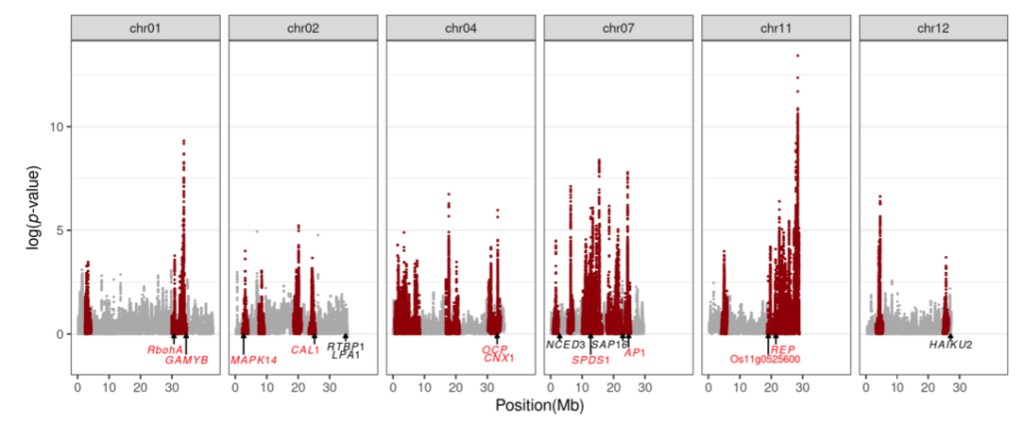 The cross between genetically distant parents is an essential source of genetic variation. This process, known as hybridization, might result in the loss of adaptive gene combinations due to the introduction of non-adaptive alleles. However, Imaizumi and colleagues show this is not the case with weedy rice and seed dormancy. In this study, the authors conduct a thorough genomic analysis of different weedy rice strains from Japan, including one derived from the hybridization of weedy and cultivated rice. Seeds from this hybrid strain exhibited seed dormancy, an adaptive characteristic also found in other weedy rice but not cultivated ones. Accordingly, the hybrid strain was found to have most of the adaptive allele combinations found in their weedy parents, even having equal representation of both parent genomes. The authors suggest that, given its ecological advantages, a positive selection of genes associated with seed dormancy ultimately led to their fixation in the hybrid strain genome. Therefore, this study provides a fascinating example of how adaptive traits can persist in the genome after hybridization. (Summary by Carlos A. Ordóñez-Parra @caordonezparra) Mol. Ecol. 10.1111/mec.16709
The cross between genetically distant parents is an essential source of genetic variation. This process, known as hybridization, might result in the loss of adaptive gene combinations due to the introduction of non-adaptive alleles. However, Imaizumi and colleagues show this is not the case with weedy rice and seed dormancy. In this study, the authors conduct a thorough genomic analysis of different weedy rice strains from Japan, including one derived from the hybridization of weedy and cultivated rice. Seeds from this hybrid strain exhibited seed dormancy, an adaptive characteristic also found in other weedy rice but not cultivated ones. Accordingly, the hybrid strain was found to have most of the adaptive allele combinations found in their weedy parents, even having equal representation of both parent genomes. The authors suggest that, given its ecological advantages, a positive selection of genes associated with seed dormancy ultimately led to their fixation in the hybrid strain genome. Therefore, this study provides a fascinating example of how adaptive traits can persist in the genome after hybridization. (Summary by Carlos A. Ordóñez-Parra @caordonezparra) Mol. Ecol. 10.1111/mec.16709
Concerted expansion and contraction of immune receptor gene repertoires in plant genomes
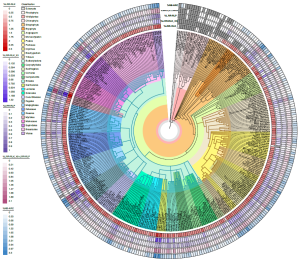 Plant immunity is crucial for adaptation to pathogen attack and subsequent survival. Two systems support plant immunity. Cell-surface pattern-recognition receptors (PRRs) recognize pathogen-associated molecular patterns (PAMPs) and prompt pattern-triggered immunity. Intracellular nucleotide-binding leucine-rich repeat (NLR) receptors are activated by pathogen effectors and cause effector-triggered immunity. Ngou et al. examined genomes from 350 plant species including 26 algal species, 5 bryophytes, 10 gymnosperms and 300 angiosperms. The authors found that expansion/contraction of NLRs is correlated with similar expansion/contraction of PRRs. They suggeste that this expansion/contraction is effected by pathogen pressure, ecological niche, and plant growth habits. Genera with highest percentage PRRs and NLR-associated domains included Triticum and Oryza, likely associated with their densely growing populations and airborne pathogens. Tree species similarly exhibited high percentage PRRs and NLR-associated domains, which may be linked with extended lifespan and associated pathogen exposure in these species. As this coordination of immune receptor expansion and contraction is not caused by genetic clustering, future work may determine what coordination mechanism is controlling this process in plant genomes. (Summary by Orla Sherwood, @orlasherwood) Nature Plants. 10.1038/s41477-022-01260-5
Plant immunity is crucial for adaptation to pathogen attack and subsequent survival. Two systems support plant immunity. Cell-surface pattern-recognition receptors (PRRs) recognize pathogen-associated molecular patterns (PAMPs) and prompt pattern-triggered immunity. Intracellular nucleotide-binding leucine-rich repeat (NLR) receptors are activated by pathogen effectors and cause effector-triggered immunity. Ngou et al. examined genomes from 350 plant species including 26 algal species, 5 bryophytes, 10 gymnosperms and 300 angiosperms. The authors found that expansion/contraction of NLRs is correlated with similar expansion/contraction of PRRs. They suggeste that this expansion/contraction is effected by pathogen pressure, ecological niche, and plant growth habits. Genera with highest percentage PRRs and NLR-associated domains included Triticum and Oryza, likely associated with their densely growing populations and airborne pathogens. Tree species similarly exhibited high percentage PRRs and NLR-associated domains, which may be linked with extended lifespan and associated pathogen exposure in these species. As this coordination of immune receptor expansion and contraction is not caused by genetic clustering, future work may determine what coordination mechanism is controlling this process in plant genomes. (Summary by Orla Sherwood, @orlasherwood) Nature Plants. 10.1038/s41477-022-01260-5
Two decades of climate change alters seed longevity in an alpine herb
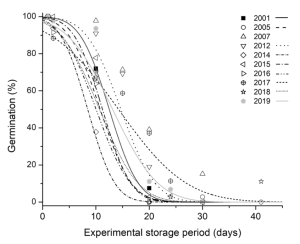 Alpine ecosystems are particularly vulnerable to climate change since they are experiencing swift temperature increases and rainfall reduction. These changes have been shown to affect different aspects of plant life history, such as phenology and germination. In this exciting research, White and colleagues show us that climate change also affects seed longevity –how long a seed can remain viable after maturation. The authors assessed ten seed bank accessions of Viscaria alpina collected from a single population from the northern Apennines (Italy) between 2001 and 2019 and looked for potential climate variables that could explain differences in seed longevity. Interestingly, they found that precipitation during the growth season was highly correlated with seed longevity, with plants that experienced drier seasons producing longer-lived seeds. This response is considered an important strategy for alpine plants to cope with harsher dry seasons. Therefore, this research provides fascinating insights into an additional effect of climate change on plant biology. Additionally, it highlights the importance and utility of ex-situ seed banks for such studies. (Summary by Carlos A. Ordóñez-Parra @caordonezparra) Alp. Bot. 10.1007/s00035-022-00289-8
Alpine ecosystems are particularly vulnerable to climate change since they are experiencing swift temperature increases and rainfall reduction. These changes have been shown to affect different aspects of plant life history, such as phenology and germination. In this exciting research, White and colleagues show us that climate change also affects seed longevity –how long a seed can remain viable after maturation. The authors assessed ten seed bank accessions of Viscaria alpina collected from a single population from the northern Apennines (Italy) between 2001 and 2019 and looked for potential climate variables that could explain differences in seed longevity. Interestingly, they found that precipitation during the growth season was highly correlated with seed longevity, with plants that experienced drier seasons producing longer-lived seeds. This response is considered an important strategy for alpine plants to cope with harsher dry seasons. Therefore, this research provides fascinating insights into an additional effect of climate change on plant biology. Additionally, it highlights the importance and utility of ex-situ seed banks for such studies. (Summary by Carlos A. Ordóñez-Parra @caordonezparra) Alp. Bot. 10.1007/s00035-022-00289-8



